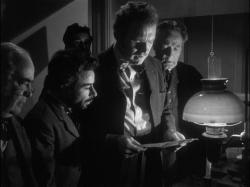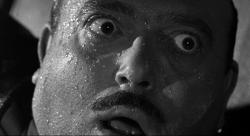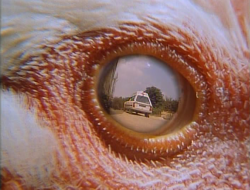Reviews
Sam Fuller
USA, 1961
Credits
Review by Thomas Scalzo
Posted on 03 December 2012
Source Columbia Pictures DVD
Categories Samuel Fuller: Deep Cuts
There’ll always be people like us.
Earl Connors, Organized Crime Kingpin
To the casual observer, this early ’60s offering from Samuel Fuller has all the earmarks of a prototypical film noir: the stark black and white photography, the overly dramatic score, the hardboiled men, the faint-hearted women, the wily criminals deftly evading the rule of law, and the tireless servant of the people doing his best to bring the hoodlums to justice. Yet, upon closer examination, it becomes clear that despite adorning his film with the requisite noir trappings, Fuller is not crafting a predictable genre throwback. Indeed, as scene after unexpected scene unfolds, we realize that the intent of the film is not to imitate, but to undermine—to tear through the genre’s stylish surface and expose its brutal core. Though Fuller never seems entirely sure which way to turn on this new noir terrain, witnessing the man trying to find his way is an absorbing - and at times startling - experience.
We begin with young Tolly Devlin, the unfortunate son of a luckless underworld pawn. One dark and lonely night, Tolly’s father is beaten to death as the youngster looks on. Bereft of family support, Tolly inevitably turns to crime, winding up first in juvenile detention, and finally in the big house. The passage of time, however, does nothing to blunt Tolly’s anger at the four men who brutally clobbered his father. In what can only be described as a preternatural dedication to vengeance, Tolly has apparently spent every moment of his formative years thinking about what he will do once he’s back on the streets. Thus, as soon as he is released from prison, he immediately begins to plot his payback—first charming his way into the inner circle of the powerful Connors crime syndicate, and then slyly setting up each of his victims for the justice he has dreamt of for so long.
Taken at face value, the tale of Tolly and his quest for vengeance is entertaining, but hardly remarkable when considered alongside the timeless classics of the genre. In the hands of Fuller, however, the various plot elements are merely the means by which his relentless series of unsettling scenarios and sinister characterizations can occur. Instead of burying the cold-blooded brutality of his story beneath a series of colorful adventures and suave mobsters, Fuller forces us time and again to focus on the soulless cruelty underpinning the narrative. From a man being burned alive, to a little girl run over by a car, to the callous suggestion that selling drugs to school children would help increase profits, each successive scene drags us deeper and deeper into the pitiless world of organized crime, offering an unflinching view of this vile and decidedly unglamorous way of life.
This dedication to stare unblinking in the face of such horrors is mirrored in Fuller’s restless camerawork. Time and again, we start a scene at a comfortable distance from the players, only to find ourselves creeping slowly forward, zooming in closer and closer to the action until a sense of unease becomes palpable. Couple this unsettling technique with Fuller’s penchant for extreme close-ups and jump cuts, and it is difficult not to be overcome with a feeling of disquietude. It is thus a credit to Fuller’s talents that despite such potentially off-putting techniques, and a reliance on a series of rather deplorable events, his intense, engaging set pieces consistently command our attention and refuse to allow us to look away.
It is understandable that the criminal element of a film such as this would naturally be suited for such scrutiny, and it is not surprising that Connors and his cohorts prove themselves capable of horrendous deeds. What does come as a surprise, however, is how utterly unlikable Tolly, the supposed hero of the film, demonstrates himself to be. Despite starting out with a surfeit of pity from his father’s violent death, Tolly quickly shows that he’s no better than the men he has devoted his life to killing. Whether slapping an old man in the face and denying his dying wish, cruelly mocking a young woman’s declaration of love, or snidely calling her a sucker for putting herself on the line to help him out, Tolly over and again proves himself to be a jerk. The closer we get to his character, the less we like him. And that, it seems, is Fuller’s goal: to force us to see the truth behind these characters and this way of life.
Despite his obvious fixation on the unpleasant nature of these people and their world, Fuller does manage to keep the story grimly fascinating, as we wonder who will next fall victim to Tolly’s machinations, and how will he meet his doom. However, when the time inevitably arrives for a climax and conclusion, Fuller seems unsure of what path he wants to follow: Should he work in more plot twists, more double crosses, more backstabbing? Should he reaffirm his points about the vileness of the criminal underworld and leave us mired in despair? Sadly, he chooses neither route, tossing together an unsatisfying mix of unrealistic love followed by a predictable shootout. Perhaps the studio couldn’t abide a complete realization of Fuller’s dark vision and still expect people to want to come to the theatre. Or maybe Fuller feared that an overabundance of plot twists would provide the audience with too many distractions from the main points he was trying to make. Whatever the reason, once the film loses its direction, it is never quite able to find it again.
Still, as an early experiment in what would become neo-noir, Fuller’s creation is a fascinating effort that undoubtedly paved the way for countless more fully realized noirs to follow, including several by Fuller himself. And to dwell overlong on the unsatisfying conclusion is to belittle the fascinating spectacle of all that came before: the ice-cold characters, the remorseless camera, the austere world of sharp lines and pitch-black shadows, in other words, it is the world of film noir, as imagined by the judgmental, unflinching, and demanding mind of Sam Fuller.
More Samuel Fuller: Deep Cuts
-

Verboten!
1959 -

Park Row
1952 -

Underworld U.S.A.
1961 -

The Day of Reckoning
1990 -

The Madonna and the Dragon
1990
We don’t do comments anymore, but you may contact us here or find us on Twitter or Facebook.



